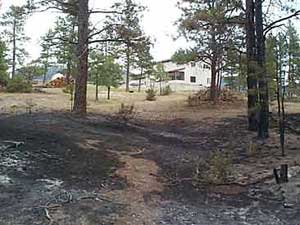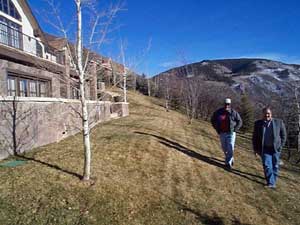Even the best structure defense technologies won’t work without the key to home fire defense: DEFENSIBLE SPACE. Defensible space is an area around a structure where fuels and vegetation are treated, cleared or reduced to slow the spread of wildfire towards the structure. It also reduces the chance of a structure fire moving from the building to the surrounding forest. Defensible space provides room for firefighters to do their jobs. Your house is more likely to withstand a wildfire if grasses, brush, trees and other common forest fuels are managed to reduce a fire’s intensity.
Two factors have emerged as the primary determinants of a home’s ability to survive wildfire. These are:
- The home’s roofing material
- The quality of the “defensible space” surrounding it.
Use fire-resistive materials (Class C or better rating), not wood or shake shingles, to roof homes in or near forests and grasslands. When your roof needs significant repairs or replacement, do so with a fire-resistant roofing material. Check with your county building department. Some counties now restrict wood roofs or require specific classifications of roofing material.
 Defensible space allows firefighters to safely defend property. A sensible defensible space plan increases the chances of your home surviving a wildland fire. Note how this home was saved because of it’s defensible space. |
 Under normal circumstances, a fire would quickly move uphill, heating up and then burning anything uphill from it. Note how this homeowner removed brush and thick vegetation from around his property. His home has a high chance of surviving a wildfire. |
Quick Facts on Defensible Space:
- Wildfire will find the weakest links in the defense measures you have taken on your property.
- The primary determinants of a home’s ability to survive wildfire are its roofing material and the quality of the defensible space surrounding it.
- Even small steps to protect your home and property will make them more able to withstand fire.
- Consider these measures for all areas of your property, not just the immediate vicinity of the house.
- Quite often during a wildfire threat, fire agencies will pre-deem a home a casualty because of bad defensible space. This decision is made before the fire gets there!! The means the agency will use resources on a home with a better chance of survival.
From Firewise.org, here is your defensible space and FireWise annual safety checklist:
- Trees and shrubs are properly thinned and pruned within the defensible space. Slash from the thinning is disposed of.
- Roof and gutters are clear of leaves, needles, and other debris.
- Branches overhanging the roof and chimney are removed.
- Chimney screens are in place and in good condition.
- Grass and weeds are mowed to a low height.
- An outdoor water supply is available, complete with a hose and nozzle that can reach all parts of the house.
- Fire extinguishers are checked and in working condition.
- The driveway is wide enough. The clearance of trees and branches is adequate for fire and emergency equipment. (Check with your local fire department.)
- Road signs and your name and house number are posted and easily visible.
- There is an easily accessible tool storage area with rakes, hoes, axes and shovels for use in case of fire.
- You have practiced family fire drills and your fire evacuation plan.
- Your escape routes, meeting points and other details are known and understood by all family members.
- Attic, roof, eaves and foundation vents are screened and in good condition. Stilt foundations and decks are enclosed, screened or walled up.
- Trash and debris accumulations are removed from the defensible space.
- READ MORE INFORMATION ON HOW TO MAKE YOUR HOME FIREWISE
Want to learn more about defensible space and how to protect your home from wildland fire? Here are some other sites you may want to visit:\
You must be logged in to post a comment.